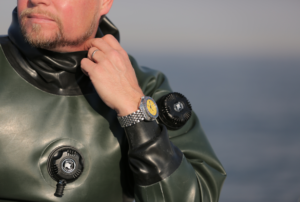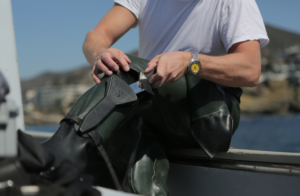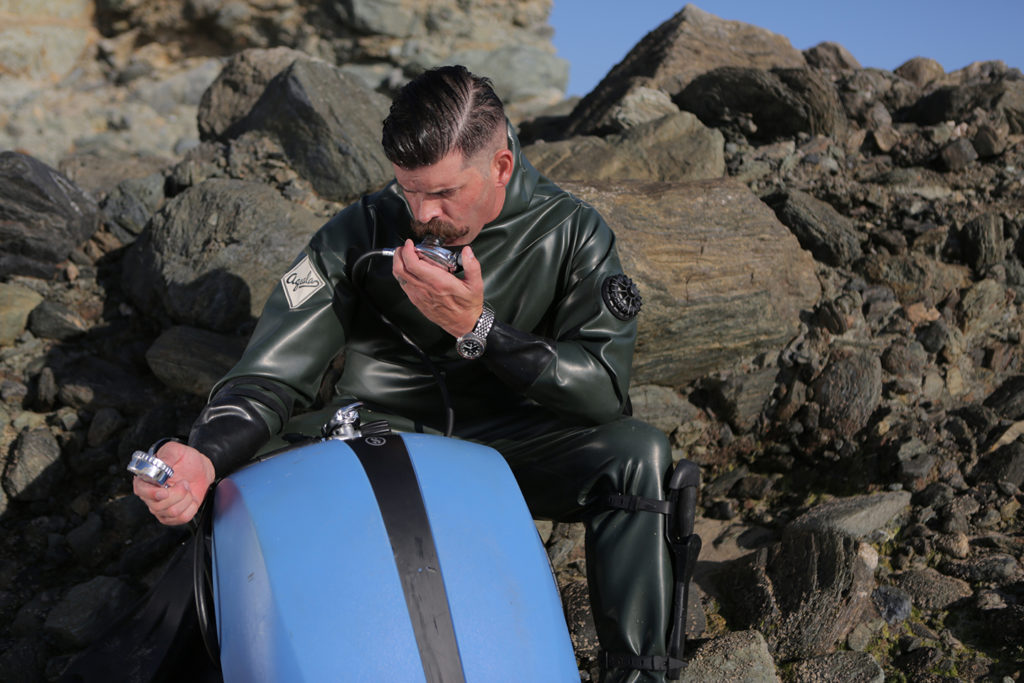Aquala and DOXA
If you’ve had a chance to view the location photos of our suits, you might notice a common element amongst all the shots. Yes, our suits share common signature features, like the “Water green” color and the round reinforcing patches, but there’s something else. That something, while standard equipment in its day, is almost non-existent in a modern diver’s inventory. That thing...is a watch.
My diving began in the days before diving computers, so a watch was essential equipment for tracking one’s time underwater. When you dive, it’s all about the time. Dedicated digital bottom timers were starting to become available, but nothing said: “I’m a diver” like wearing a diving watch. It was a piece of equipment, that unlike your regulator, could be worn and used every day. Just a glance at your wrist, and not only did it give you the time, but your mind filled with memories of past diving adventures and you began to look forward to dives still to come.
Computers did eventually become my dive time monitor, at least for a while, but the dive watch never left my wrist. Over the year, I’ve grown a small collection that includes a piece or two from Rolex, maybe an Omega or IWC, but the brand most prominent in the collection is a Swiss brand named DOXA.
 DOXA has been making watches since 1889 but didn’t enter the diving watch scene until the mid-1960s. Before that, most dive watches were design variations of the Rolex Submariner and the Blancpain Fifty Fathoms. Those watches were developed around 1953 and ‘54 out of military and commercial diving needs. All featured either black or white dials, they had slim hands, a basic strap or bracelet, and a small diameter case. No one had developed anything specifically for the rapidly expanding sport diver market, and DOXA knew that must change. They consulted Jacques Cousteau, his chief diver Claude Wesley, and together they developed a revolutionary design that stood the dive watch world on end. It was larger than anything previously seen, the hands were maximized for visibility, the bracelet compensated for pressure, and the dial was bright orange. They eventually issued other colors, but orange was their thing, and this was the watch to have in the late ‘60s and ‘70s. Except for a brief hiatus during the quartz watch crisis, they’re still making them today.
DOXA has been making watches since 1889 but didn’t enter the diving watch scene until the mid-1960s. Before that, most dive watches were design variations of the Rolex Submariner and the Blancpain Fifty Fathoms. Those watches were developed around 1953 and ‘54 out of military and commercial diving needs. All featured either black or white dials, they had slim hands, a basic strap or bracelet, and a small diameter case. No one had developed anything specifically for the rapidly expanding sport diver market, and DOXA knew that must change. They consulted Jacques Cousteau, his chief diver Claude Wesley, and together they developed a revolutionary design that stood the dive watch world on end. It was larger than anything previously seen, the hands were maximized for visibility, the bracelet compensated for pressure, and the dial was bright orange. They eventually issued other colors, but orange was their thing, and this was the watch to have in the late ‘60s and ‘70s. Except for a brief hiatus during the quartz watch crisis, they’re still making them today.
I discovered DOXA around 2005 through an online watch community. What impressed me most was how involved they were with their customers and collectors. They weren’t like other brands, where the first point of contact was with a retail salesperson. No, you were conversing with the company executives themselves, and that was a new experience. A purchase was soon made.
Eleven years later, not only do I have a few of their pieces in my collection, but I’ve become a part of their team. I’ve become a moderator for their forum, I’ve delivered 31 watches to Fabien Cousteau for his Mission 31 project at the Aquarius Undersea Research Station. I’ve rekindled their relationship with US Divers/Aqualung, and I host an annual diving trip for collectors called Searaider in Grand Cayman. Everything they do is retro and cool, so when it came time photograph the Monterey and Cordell suits, DOXA was the only choice.
For the Monterey, I chose a black dial variant called the Sharkhunter. While every model is called a Sub, DOXA gave each dial color its own unique name. I grabbed a Sharkhunter because I felt it paired best with the large black dial of the Italian made Scubapro gauge. Both watch and gauge shared bright metals, big dials, and loads of luminous material. They looked like they were made for each other.
Underwater it performed flawlessly as the stark white hands contrasted well against the all-black dial. The photo sequence dives were short, but monitoring bottom time was important. It was vintage style with a specific purpose, and it wore well for this task.

On the surface was a different story. It just needed to look good and Brian Abney, our topside guy, wore it best. I mentioned in an earlier post that it’s the people who have made this project fascinating, and Brian is no exception.

Brian models on the side, but his true calling is with the Orange County Fire Authority. He’s part of the OCFA Helicopter Paramedic Rescue Unit, as well as a truck-based firefighter paramedic. If that’s not enough, he’s also a Medical Specialist on the FEMA USAR California Task Force Team 5. You can’t always use the word cool to describe someone, but you can use it to describe Brian. He was a great person to work with.
The Cordell suit called for something different, especially since we featured a woman in the scene. That woman was fitness and lifestyle coach, Steph Tarnofsky.

Steph and her husband Josh, travel and teach the benefits of healthy living. I recently saw an announcement where they are expecting their first child, so congratulations to them both!
The male talent for the Cordell was LA actor and model, Danny Nunez. Danny had never been in a full diving rig, and was as stoked about the shoot as we were. It’s great seeing excitement and enthusiasm in other peoples’ faces.

Danny’s rig was all green and black, so we needed a punch of color. The yellow dialed DOXA Divingstar was the choice. The Divingstar model came later for DOXA, as further research showed that yellow was actually more visible underwater than orange. None knew this more than France’s Marine Nationale, as the French Navy issued them to their combat divers in the 1980s. Steph was equipped with a black dial, ladies DOXA Sub called a Seamaid. Ladies Subs are somewhat rare, and this one is especially rare. It was assembled especially for my wife as a Christmas gift for our first year together.

Cool watches, cool suits, and some really great talent made these shoots more fun than work. Like they say, if you find something you really enjoy, you never have work a day in your life. There’s definitely some truth to that.
Ty Alley